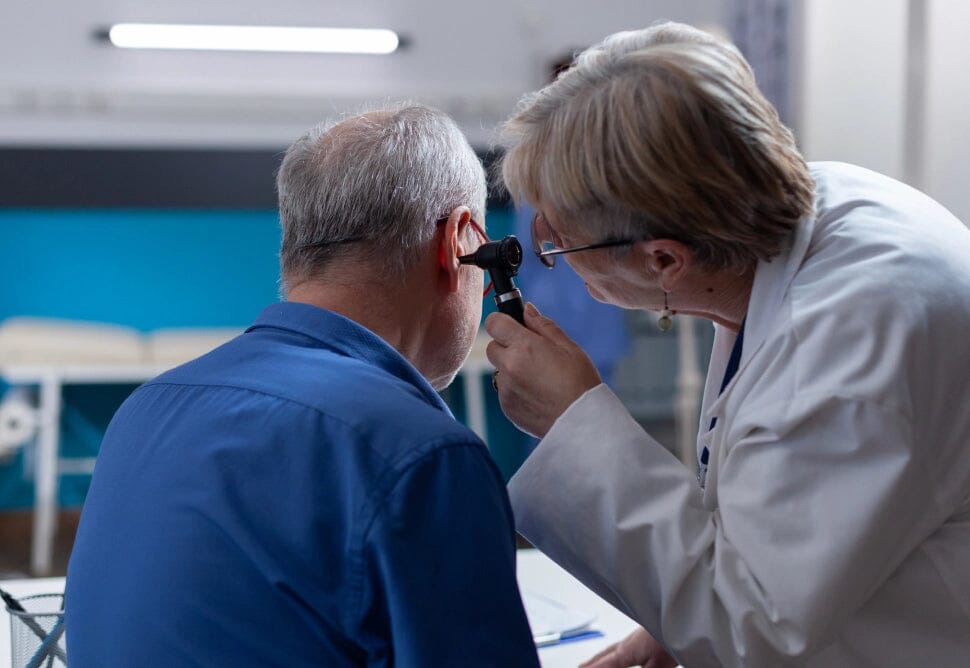Key Takeaways
- Conductive hearing loss occurs when sound cannot efficiently travel through the outer ear canal to the eardrum and the tiny bones of the middle ear.
- Common causes include earwax blockage, fluid in the middle ear, and ear infections.
- Symptoms often involve a reduction in sound level or the ability to hear faint sounds.
- Diagnosis typically involves a physical examination, hearing tests, and potentially imaging studies.
- Treatments range from simple wax removal to surgical procedures, depending on the cause.
- Nano Hearing Aids offers a selection of over-the-counter hearing aids suitable for individuals with perceived mild to moderate conductive hearing loss, providing an accessible solution without a prescription.
What is Conductive Hearing Loss?
Imagine sound as a wave, traveling through the air, eager to reach its destination: your brain. But what happens when there's a roadblock? That's conductive hearing loss in a nutshell. It's a form of hearing impairment where the path that sound waves take to reach your inner ear is blocked or reduced. This can mean that softer sounds become hard to hear, and louder sounds might not be as clear as they should be.The severity of Conductive hearing loss can range from mild to profound, based on the level of damage incurred.
Degrees of conductive hearing loss:
- Mild conductive hearing loss: 26 to 40 dB - You may struggle to hear whispers, distant conversations, or sounds in a noisy environment.
- Moderate conductive hearing loss: 41 to 55 dB - Normal conversations can be challenging to understand, especially with background noise.
- Severe conductive hearing loss: 56 to 70 dB - You may only hear loud speech or sounds, making daily communication difficult without a hearing aid.
Causes of Conductive Hearing Loss
The causes of conductive hearing loss are varied, and identifying the root cause is the first step towards effective treatment. It's not always down to one single issue, and sometimes a combination of factors may be at play.
Common Causes:
- Earwax Buildup: It's natural to have earwax, but too much can block sound from getting through.
- Fluid in the Middle Ear: Whether from colds, allergies, or infections like otitis media, fluid can muffle sounds.
- Otosclerosis: This is a bone disease affecting the middle ear, and it can lead to hearing loss.
- Eardrum Perforation: A hole or tear in the eardrum can prevent it from vibrating in response to sound waves.
Symptoms of Conductive Hearing Loss
Recognizing the symptoms of conductive hearing loss is key to seeking timely treatment. Here's what you might notice:
Look out for these indicators:
- Ear Fullness Sensation: Experiencing pressure or fullness in the ears.
- Altered Sound Perception: Voices and sounds appearing muffled or distant.
- Challenges with Noise: Struggling to hear in loud settings or during phone conversations.
- Ear Discomfort: Encountering pain, itching, or irritation in the ears along with hearing loss.
Remember, these symptoms can be temporary or permanent, and the impact can vary greatly from person to person. If you or someone you know is experiencing these signs, it's crucial to consult a healthcare professional for a proper diagnosis and to explore treatment options.
Diagnosing Conductive Hearing Loss
To pinpoint the cause of conductive hearing loss, a thorough evaluation by a healthcare professional is essential. This typically involves a series of steps that may include a physical exam of the ears, hearing tests, and possibly imaging studies. The process is straightforward and aims to provide a clear diagnosis to inform the best treatment path.
The first step is often a physical examination, where the doctor will look into your ears using an instrument called an otoscope. They're checking for any obvious signs of blockage, infection, or abnormalities. Following that, you might undergo a series of hearing tests, also known as audiometric tests, which can determine the type and degree of hearing loss you're experiencing.
In some cases, if the cause isn't clear from the physical exam and hearing tests, your doctor might recommend imaging studies, such as an MRI or CT scan. These can help identify structural problems or abnormalities that might be contributing to the hearing loss.
Treatment Options for Conductive Hearing Loss
Once conductive hearing loss is diagnosed, the treatment options will vary depending on the underlying cause. The good news is that many forms of this type of hearing loss are treatable, and in some cases, full hearing can be restored.
Medical Treatments: Antibiotics and Antifungal Medications
For infections such as otitis media or external ear infections, antibiotics or antifungal medications are often prescribed. These can clear up the infection and reduce inflammation, allowing sound to travel more freely to the inner ear.
When the cause is due to earwax blockage, a simple cleaning performed by a professional can provide immediate relief. Over-the-counter drops may also be recommended to soften the wax and facilitate its natural removal.
For allergic reactions causing fluid build-up, antihistamines or decongestants might be suggested to reduce the fluid in the middle ear. Steroids can also be prescribed in some cases to decrease inflammation and improve hearing.
Surgical Intervention: When is it Necessary?
Surgical options are considered when medical treatments aren't effective or when there's a physical abnormality that needs correcting. For instance, tympanoplasty can repair a perforated eardrum, and mastoidectomy can clear persistent infections in the mastoid bone. Otosclerosis, a condition where the stapes bone in the middle ear becomes immobile, may be treated with a procedure called stapedectomy to improve sound conduction.
Surgery is a significant step and is typically reserved for cases where it's likely to improve hearing significantly or when other treatments have failed to resolve the issue.
Hearing Aid Solutions: Exploring Available Devices
When hearing loss cannot be corrected medically or surgically, hearing aids can be a practical solution.

There are various types of hearing aids designed specifically for conductive hearing loss:
- Air Conduction Hearing Aids: These devices amplify sound waves and are suitable for various types of hearing loss, including conductive.
- Bone Conduction Hearing Aids: These bypass the outer and middle ear entirely, sending sound directly to the inner ear through the bones of the skull.
- Bone-Anchored Hearing Systems: For those who cannot use traditional hearing aids, these devices are surgically implanted and provide direct bone conduction.
It's important to work with an audiologist to determine which device is best suited for your specific needs and to ensure that it's properly fitted and adjusted.
Living with Conductive Hearing Loss
Living with hearing loss can be challenging, but with the right support and adaptations, it's possible to lead a full and active life. Staying connected with friends and family, engaging in social activities, and using assistive listening devices can all help maintain a high quality of life.
For those in school or work environments, accommodations such as preferential seating, speech-to-text applications, or other assistive technologies can be invaluable. Most importantly, maintaining open communication with those around you about your hearing loss and needs can foster understanding and support.

Can Conductive Hearing Loss be Prevented?
While not all causes of conductive hearing loss can be prevented, there are proactive steps you can take to protect your ears and hearing health. It's about being mindful of the risks and taking action to minimize them whenever possible.
For instance, regular cleaning of your ears can help prevent wax build-up, but it's crucial to do it safely. Avoid using cotton swabs or inserting any objects into your ear canal, as these can push wax deeper and potentially cause damage. Instead, consider over-the-counter ear drops to soften wax, or have your ears professionally cleaned by a healthcare provider.
Protecting your ears from loud noises is another key step. If you work in a noisy environment or enjoy loud concerts, use ear protection such as earplugs or earmuffs to shield your ears from potential damage. Steps one can take to minimize the risk:
- Object Insertion Caution: Refrain from inserting items into your ears, such as cotton swabs.
- Loud Noise Protection: Employ ear protection when in noisy environments.
- Ear Dryness: Ensure ears remain dry to avert infections; carefully dry ears after swimming or showering.
- Allergy and Cold Management: Address allergies and colds quickly to prevent fluid accumulation in the middle ear.
- Routine Healthcare Visits: Schedule consistent check-ups with a healthcare provider to detect any problems early.
By following these steps, you can take charge of your ear health and reduce the likelihood of developing conductive hearing loss. Remember, early intervention is often key to preventing more serious complications.
Nano OTC Hearing Aids for Perceived Mild to Moderate Conductive Hearing Loss

For those with perceived mild to moderate conductive hearing loss, over-the-counter (OTC) hearing aids might be a suitable option. Nano Hearing Aids is one such provider that offers a range of devices designed to improve hearing without the need for a prescription. But it's important to note that OTC hearing aids aren't for everyone. OTC hearing aids may be beneficial for some, but they may not be adequate for more severe cases or for those with specific medical conditions affecting their hearing.
Frequently Asked Questions (FAQ)
What is the main difference between conductive and sensorineural hearing loss?
Conductive hearing loss occurs when there's a problem conducting sound waves anywhere along the route through the outer ear, tympanic membrane (eardrum), or middle ear. Sensorineural hearing loss, on the other hand, occurs when there's damage to the inner ear or the nerve pathways from the inner ear to the brain.
Can conductive hearing loss get worse over time?
It can, especially if left untreated. The underlying causes, such as chronic ear infections or progressive conditions like otosclerosis, can lead to worsening hearing if not properly managed.
Are there any lifestyle changes that can help with conductive hearing loss?
Yes, in addition to the preventative steps already mentioned, maintaining a healthy lifestyle that supports overall ear health is beneficial. This includes regular exercise, a balanced diet, and avoiding smoking, which can all contribute to better hearing health.
What causes conductive hearing loss?
Conductive hearing loss occurs when there's an issue with the ear's ability to conduct sound waves through the outer ear, tympanic membrane (eardrum), or middle ear. Common causes include ear infections, fluid in the middle ear, earwax blockage, a perforated eardrum, stiffening of the middle ear bones (otosclerosis), and congenital abnormalities.
How is conductive hearing loss diagnosed?
A healthcare provider or audiologist will review your medical history and symptoms, conduct a physical examination of your ears, and perform hearing tests, such as pure tone audiometry and tympanometry, to diagnose conductive hearing loss.
Can Nano OTC hearing aids help with conductive hearing loss?
Yes, Nano OTC hearing aids are specifically designed for individuals with perceived mild to moderate conductive hearing loss, providing an effective solution without a prescription.




